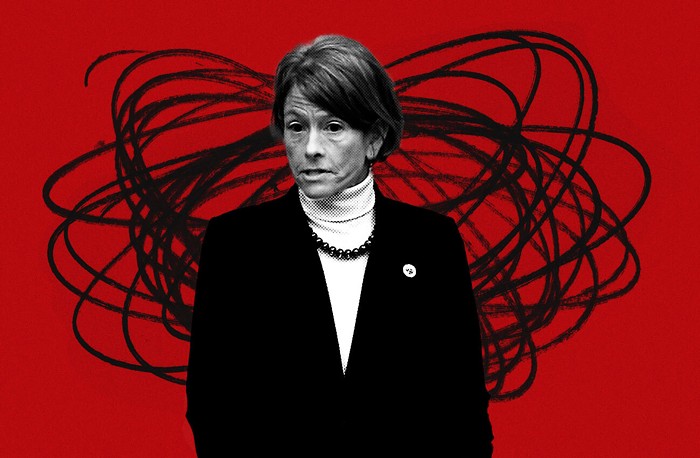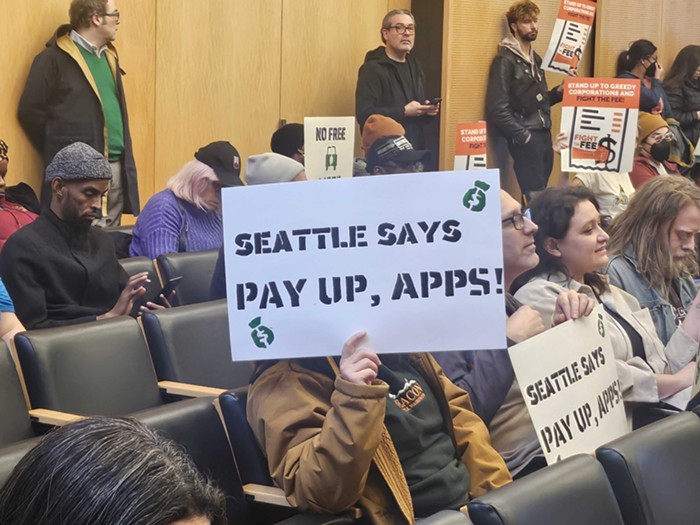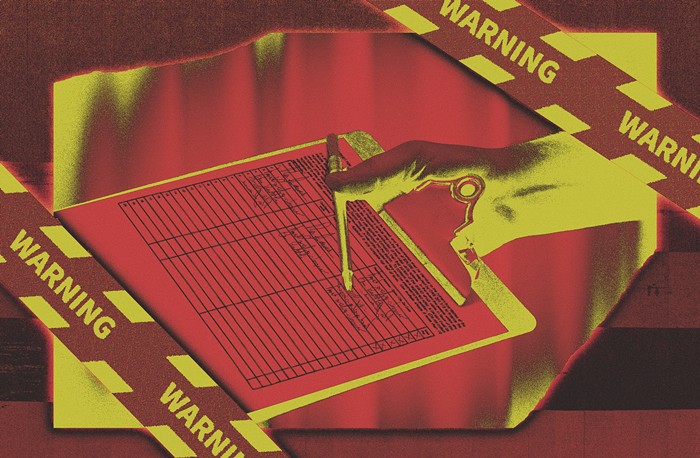Bruce Harrell seemed like he was in a hurry. State representatives were answering questions from city council members about the plan to spend two weeks drilling a giant tunnel under the Alaskan Way Viaduct, Seattle's aging elevated highway. But the Seattle City Council president reminded his colleagues that council time was ticking by.
"Page four of a 19-page PowerPoint over there," he said, signaling that there were many PowerPoint pages left to go in this presentation and he wanted to move on past the questions. Todd Trepanier, the Washington State Department of Transportation's tunnel project administrator, thanked Harrell for being conscious of time constraints.
Really, the state's whole presentation on drilling beneath the viaduct felt brief and perfunctory—even though as the council was listening to the briefing, workers in a hyperbaric gas bubble were undertaking some of the most challenging and expensive maintenance work on the machine to date. We don't know exactly when Bertha will be ready to dive under the viaduct after the machine's underground touch-up at "Safe Haven 3," though the state says it's sometime soon.
When that happens, no one's going to be riding on the viaduct between South Spokane Street and the Battery Street Tunnel. (That much is a relief.) But bigger questions loom. In recent months, the state's contractor for the project, Seattle Tunnel Partners (STP), has come under fire from Governor Jay Inslee. Not only did Inslee temporarily halt operations after a sinkhole opened up near Bertha's cutterhead; a follow-up story in the Seattle Times revealed that state engineers and officials had worried over STP's process before the sinkhole opened up.
So what happens if a sinkhole opens up while the machine is drilling underneath the viaduct? Could it affect the structural integrity of the highway itself? Why wasn't STP operating under better supervision from day one? And at what point would the viaduct become too unsafe for people to use?
These are questions that some city council members have had from the beginning of the project—well before the 57-foot-wide tunnel-boring machine started running into almost every problem imaginable. But now, just before one of the trickiest phases of the project, those questions remain mostly unanswered.
Here's anything and everything resembling answers I was able to get out of all nine city council members (only two responded), former mayor Mike McGinn's consultant on the tunnel project, and the state:
1. What happens if a sinkhole opens up while Bertha is drilling underneath the viaduct?
Short version: "We don't know," according to the state.
"There are many measures STP can take if they see a loss of soil; one measure is injecting grout into the ground from inside the machine," Washington State Department of Transportation (WSDOT) spokesperson Laura Newborn told me in an e-mail. "A soil loss does not necessarily result in a sinkhole."
In addition to emergency grout-shooting, STP has also inserted steel micropiles near Yesler Way—little support pillars that are supposed to stabilize the soil when the machine gets close to the bents of the viaduct.
2. If a sinkhole opens up beneath the viaduct, could it threaten the structural integrity of the highway itself?
"We can't speculate, as every situation is different," WSDOT's Newborn said. "As Todd [Trepanier] mentioned in his presentation, we will have a command center operating 24/7 as the machine is tunneling underneath to quickly address any situation that might develop."
Thom Neff, the infrastructure consultant former mayor McGinn once hired to assess the tunnel project, has a different view. "They're still in an area that's classified as urban fill, which is very, very complicated," Neff said. "They claim they've done a lot of grouting underneath the viaduct and have reinforced concrete piers, but if a sinkhole develops while Bertha is under the viaduct, it causes potential danger and risk to the foundations, and I would think at that point either SDOT or WSDOT would declare the viaduct unsafe and not reopen it. If something happens while it's under it, I think it's a whole new ball game."
3. So when does the viaduct become too unsafe to use?
Todd Trepanier told the city council that a March viaduct inspection showed no new cracks, which was a good sign.
That said, the same inspection found 5/16 of an inch of additional settlement by Seneca Street, and between 1/8 and 1/4 of an inch of settlement near the Columbia Street on-ramp.
"I've been frustrated with the lack of clarity on questions, specifically around at which point does the viaduct become so unsafe that we close it short-term or permanently," city council member Mike O'Brien said. "The answer we got is: 'It depends.' And 'It's too complicated for us to actually describe.' That continues to be a sore point for me."
Neff, McGinn's former tunnel consultant, told me no one in his field is willing to go out on a limb and call the viaduct "safe." "You'd have to be insane to do that," he said. "And if you have another earthquake somewhere along the line, you don't even want to think about that."
4. ANYWAY, so you guys are SURE everything tunneling-wise is A-OK, right? It's all gonna be great?
City council member Rob Johnson said he was encouraged by the fact that the state had brought in new levels of oversight for tunneling going forward. "I have to take [the state] at face value when they're the technical experts," Johnson said. "If they feel like what they're seeing is an improvement, I have to take their word for it."
Of course, the state has only been able to witness improvement from STP over the last 300 feet, since that's when Inslee made STP stop and reassess their work.
But if—if—there is a silver lining to moving forward with drilling under the viaduct, Council Member Mike O'Brien believes it's showing the public that we might not need the viaduct (or the goddamn tunnel, for that matter) at all.
"I'm encouraged to see that the volume of traffic on the viaduct has been cut nearly in half to 60,000 vehicles a day," O'Brien said. "That makes our challenge around a closure that much more manageable. It also raises the question of whether we should have been spending billions of dollars on the tunnel in the first place."
5. So yeah, wait, why are we doing this again?
... ![]()



















